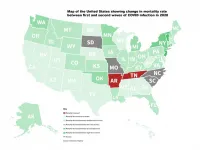(Press-News.org) Wealthier northeastern US states and Western European countries tended to have significantly lower mortality rates during second-wave COVID-19 infections, new research from the University of Sydney and Tsinghua University has shown. However, the pattern was not as general as expected, with notable exceptions to this trend in Sweden and Germany.
Researchers say mortality change could have several explanations:
European first-wave case counts were underestimated;
First-wave deaths disproportionately affected the elderly;
Second-wave infections tended to affect younger people;
With some exceptions, lower mortality rates occurred in countries with more socialised and equitable health systems.
The researchers, Nick James, Max Menzies and Peter Radchenko, believe their new methodology could assist epidemiologists to analyse data consistently to assess the impact of COVID-19 mortality across populations.
"We have been able to look at the mortality rates in a more dynamic way," said Mr James from the University of Sydney.
They have published their results today in the mathematical journal Chaos.
"We take a time series of infection rates by country, apply an algorithmic approach to chop it up into first and later waves and then do some relatively simple optimisation and calculations to determine two different mortality numbers," said Nick James, a PhD student in the School of Mathematics & Statistics at the University of Sydney.
The mortality rate of the massive European second wave turned out to be less severe than expected: at least with respect to reported cases and deaths. The researchers wanted to know how big that drop in mortality was and how it differed between countries.
"We think answering these questions is important and we wanted to answer this for all of Europe, not just the wealthier Western countries," said Dr Max Menzies from Tsinghua University. "In Belarus, for example, the mortality rate actually increased during its second wave, while Ukraine and Moldova were still in their first wave as of the end of November 2020."
The researchers discovered this was very different from the Netherlands, Belgium, France, and other countries that drastically reduced their mortality rates - at least with respect to reported numbers - between their first and second waves.
The differences tended to be less marked in the United States, with a flatter outcome. However, states such as New York, New Jersey and Connecticut, which were particularly hard hit in the first wave saw second-wave mortality rates decline in line with many western European countries.
Using a sophisticated mathematical model, each country in Europe and each state in the US was given a mortality data point for the first and second waves. Comparing these figures gives each country or state a data point, or mortality ratio.
In Europe, only Belarus - with a data point of 0.72 - saw a ratio below 1.0, which means that its mortality increased. In the US two states - Arkansas (0.69) and Tennessee (0.88) - had ratios below 1.0 indicating an increase in mortality.
Countries that experience a more than tenfold decrease in mortality in Europe were: Belgium (11.25), Denmark (14.28), France (13.67), the Netherlands (16.17).
"Our work shows sharp drops in mortality with respect to reported cases and deaths," Dr Menzies said. "However, the problem will always be what is the true number of cases in the early first wave? We may never know, but we imagine future research and analysis will try to determine it."
When the researchers reran their analysis on estimated true cases and estimated deaths, Associate Professor Peter Radchenko, from the University of Sydney Business School, pointed out that those measures show serious limitations.
"Excess mortality can be negative relative to previous years due to fluctuations from other causes, so it's unsuitable for measuring the true numbers of COVID-19 deaths," Associate Professor Radchenko said. "We hope others will more closely analyse the true numbers, perhaps using more specialised data such as out of particular hospitals or regions where testing was more reliable."
Broad similarity was also observed between Europe and the US, where northeastern states behaved similarly to wealthy Western European countries in their sharp reductions of mortality during the second wave.
INFORMATION:
DOWNLOAD research plus maps of Europe and the US at this link.
INTERVIEWS
Nicholas James | nicholas.james@sydney.edu.au
Dr Max Menzies | max.menzies@alumni.harvard.edu
MEDIA ENQUIRIES
Marcus Strom | marcus.strom@sydney.edu.au | +61 423 982 485
DECLARATION
There is no funding to declare for this research.
WASHINGTON, March 16, 2021 -- Cancerous cells exhibit several key differences from healthy cells that help identify them as dangerous. For instance, the pH -- the level of acidity -- within a cancerous cell is not the same as the pH within a healthy cell.
Researchers from the National University of Singapore developed a method of using machine learning to determine whether a single cell is cancerous by detecting its pH. They describe their work in the journal APL Bioengineering, from AIP Publishing.
"The ability to identify single cells has acquired a paramount importance in the field of precision and personalized medicine," ...
What The Study Did: The findings of this study suggest that, based on a sample from an otherwise healthy population, the overall number of SARS-CoV-2 infections in the U.S. may be substantially higher than estimates based on public health case reporting.
Authors: Robert L. Stout, Ph.D., of Clinical Reference Laboratory Inc. in Lenexa, Kansas, is the corresponding author.
To access the embargoed study: Visit our For The Media website at this link https://media.jamanetwork.com/
(doi:10.1001/jamanetworkopen.2021.1552)
Editor's Note: The article includes conflict of interest and funding/support disclosures. Please see the article for additional information, including other authors, author contributions and affiliations, ...
What The Study Did: Researchers examined nursing homes in communities with the highest COVID-19 prevalence to identify characteristics associated with resident infection rates.
Authors: Hye-Young Jung, Ph.D., of Weill Cornell Medical College in New York, is the corresponding author.
To access the embargoed study: Visit our For The Media website at this link https://media.jamanetwork.com/
(doi:10.1001/jamanetworkopen.2021.1555)
Editor's Note: The article includes funding/support disclosures. Please see the article for additional information, including ...
The first systematic study of its kind describes how human viruses including SARS-CoV-2 are better adapted to infecting certain types of tissues based on their ability to hijack cellular machinery and protein synthesis.
Carried out by researchers at the Centre for Genomic Regulation (CRG), the findings could help the design of more effective antiviral treatments, gene therapies and vaccines. The study is published today in the journal Cell Reports.
Living organisms make proteins inside their cells. Each protein consists of single units of amino acids which are stitched together according to instructions encoded within DNA. The basic units of these instructions are known as a codons, each of which corresponds ...
When scientists at the Institute of Science and Technology (IST) Austria looked at developing zebrafish embryos, they observed an abrupt and dramatic change: within just a few minutes, the solid-like embryonic tissue becomes fluid-like. What could cause this change and, what is its role in the further development of the embryo? In a multidisciplinary study published in the journal Cell, they found answers that could change how we look at key processes in development and disease, such as tumor metastasis.
To learn more about how a tiny bunch of cells develops into complex systems ...
CAMBRIDGE, MA -- In the past few years, several medications have been found to be contaminated with NDMA, a probable carcinogen. This chemical, which has also been found at Superfund sites and in some cases has spread to drinking water supplies, causes DNA damage that can lead to cancer.
MIT researchers have now discovered a mechanism that helps explain whether this damage will lead to cancer in mice: The key is the way cellular DNA repair systems respond. The team found that too little activity of one enzyme necessary for DNA repair leads to much higher cancer rates, while too much activity can produce tissue damage, especially in the liver, which can be fatal.
Activity ...
Several oceans' worth of ancient water may reside in minerals buried below Mars' surface, report researchers. The new study, based on observational data and modeling, shows that much of the red planet's initial water - up to 99% - was lost to irreversible crustal hydration, not escape to space. The findings help resolve the apparent contradictions between predicted atmospheric loss rates, the deuterium to hydrogen ratio (D/H) of present-day Mars and the geological estimates of how much water once covered the Martian surface. Ancient Mars was a wet planet - dry riverbeds and relic shorelines record a time when vast volumes of liquid water flowed across the surface. Today, ...
Birds breathe with greater efficiency than humans due to the structure of their lungs--looped airways that facilitate air flows that go in one direction--a team of researchers has found through a series of lab experiments and simulations.
The findings will appear Fri., March 19 in the journal Physical Review Letters (to be posted between 10 and 11 a.m. EDT).
The study, conducted by researchers at New York University and the New Jersey Institute of Technology, also points to smarter ways to pump fluids and control flows in applications such as respiratory ventilators.
"Unlike the air flows deep in the branches of our lungs, which oscillate back and forth as we breathe in and out, the flow moves in a single direction in ...
PHILADELPHIA - Imposter syndrome is a considerable mental health challenge to many throughout higher education. It is often associated with depression, anxiety, low self-esteem and self-sabotage and other traits. Researchers at the Sidney Kimmel Medical College at Thomas Jefferson University wanted to learn to what extent incoming medical students displayed characteristics of imposter syndrome, and found that up to 87% of an incoming class reported a high or very high degree of imposter syndrome.
"Distress and mental health needs are critical issues among medical ...
PITTSBURGH (March 16, 2021) ... During the swarming of birds or fish, each entity coordinates its location relative to the others, so that the swarm moves as one larger, coherent unit. Fireflies on the other hand coordinate their temporal behavior: within a group, they eventually all flash on and off at the same time and thus act as synchronized oscillators.
Few entities, however, coordinate both their spatial movements and inherent time clocks; the limited examples are termed "swarmalators"1, which simultaneously swarm in space and oscillate in time. Japanese tree frogs are exemplar swarmalators: each frog changes both its location and rate of croaking ...


